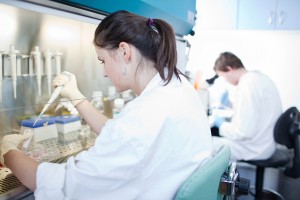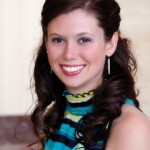 By Heather Williams
By Heather Williams
Where would you expect to find a major research instrument? A major university, laboratory or company?
One such instrument has made its way to West Virginia. Concord University, located in southern West Virginia, received its microanalytical instrument in 2010 from the University of Kentucky (UK). Through connections at UK and previous use, Dr. Joe Allen, division chair of the Natural Science department, was offered UK’s electron microprobe after UK received a younger, used instrument from Los Alamos National Lab in New Mexico. With funds from the Bucks for Brains grant, the microprobe was dismantled, moved, reassembled and improved.
The university’s microanalytical laboratory is now furnished with an Applied Research Laboratories Scanning Electron Microprobe Quantometer (ARL SEMQ), the only electron microprobe in West Virginia.
This particular microprobe was developed in the 1980s. During this time, the ARL SEMQ was a prominent research instrument; major institutions such as the Smithsonian and the University of California, Berkley used the same model. The original ARL company went out of business, causing support and developments for this instrument to fade. Today, Advanced Microbeam of Vienna, Ohio, a company formed after the original ARL company closed, provides support and instrument upgrades.
Maintenance, being the key to a functional instrument, occurs regularly. Such maintenance is expensive, and proper funding is crucial. The university’s science lab and tech fees provide funding for the routine general maintenance of the instrument, while grants are needed for major maintenance needs and upgrades.
A great amount of time and effort went into creating the lab. Moving the microprobe was no easy task. “This was a serious undertaking; it took a significant amount of work,” says Dr. Stephen Kuehn, director of the Electron Microprobe Lab. Progressively, the microprobe was dissembled, all parts carefully labeled, packed and moved. Upon being reassembled in Concord’s lab, additional time was needed to test the instrument to ensure all parts were working properly before the lab could become fully functional. In addition, equipment for sample preparation and an extensive collection of reference material for instrument calibration and quality control had to be obtained.
Being a new lab, Kuehn had to build a reference standard collection from scratch. Reference standards are samples that are already well-documented and are used to help in the identification of the sample being analyzed as well as in calibration and quality control.
Kuehn looked at major sources for reference materials and the collections of several other labs to make a list of what standards the lab should have. The collection of standards Concord has now is similar to those in more established labs and will cover the major applications. “Reference standards are a critical thing for a lab like this,” Kuehn says.
The lab now has more than 150 standards including minerals, glasses, pure metals and some synthetic materials. Some of the standards came from the Smithsonian, Harvard and U.S. Geological Survey, and others were purchased from commercial sources.
“Just because we are an undergraduate university, doesn’t mean we can’t run a first-rate lab,” Kuehn says.
To buy a brand-new electron microprobe from a current manufacturer would cost $1 to 2 million. Kuehn says that about 10 percent of the cost of a new probe has been invested into acquiring theirs. Yet, even though it is an older model, it is a fully functional machine and can accomplish 90 to 95 percent of what can be done with a new instrument.
The main objective of an electron microprobe is to identify the chemical makeup of a substance. This can include identifying the elements within that substance, determining where they are located and measuring their abundance. It is capable of analyzing any solid material that is stable in a low pressure/high vacuum environment, such as glasses, ceramics, minerals and metals.
Readying a sample for analysis occurs in several steps, with preparation of samples being the first. Kuehn says the preparation of a sample depends on the sample itself and the kind of information a researcher wants from it. For example, if a researcher would like a general idea of a sample, the prep time may take several minutes; however, if the researcher wants an in-depth look at the sample, the prep time could take hours. Teye Kalteyer, a senior environmental geoscience major, has worked on samples of volcanic ash or tephra layers. This includes sifting the ash, gluing it in epoxy cement and polishing the sample, which equals about an hour per sample.
After the samples are prepared, they make their way to the microprobe for analysis. The samples are placed on a motorized stage in the probe. Once in the probe, an electron beam hits the sample and creates X-rays, which identify the elements in the sample and produce an image at the microscopic level. Concord’s microprobe has four spectrometers, which measure the X-rays according to their wavelengths and are used to produce a chemical analysis but could have as many as 12. The ARL SEMQ is the only model to allow so many. In 2012, a new spectrometer that rapidly measures X-rays by their energies was installed with support from a grant, adding many new capabilities.
The ARL SEMQ has an advantage over other models. The geometry of the probe dictates how much sample material X-rays have to pass through from the sample to the detector. The ARL SEMQ uses the take-off angle—-the highest angle of any other microprobe—which ensures fewer X-rays are lost and better results are produced.
The accuracy and precision of analysis on the microprobe depend on the instrument conditions and quality-control materials used. The typical margin of error for a major element is between plus or minus 0.5 to 2 percent; for a minor or trace element, the margin of error is often plus or minus 10 to 30 percent. However, these numbers depend on how much time a researcher is willing to spend analyzing the sample and what kind of information is needed.
“The quality of the results from Concord’s lab make them totally publishable in major scientific journals. In fact, some already have been,” Kuehn says.
The presence of the microprobe at an undergraduate university such as Concord has given and will give many students a great opportunity and resource. “Students can really learn about the scientific process, and that’s really good for them,” Kuehn says. According to his research, out of the hundreds of undergraduate schools in the U.S., only two or three others have an electron microprobe.
Students at Concord are working with a serious piece of equipment with which they may not have otherwise had the opportunity to work. To use an instrument such as this, researchers typically pay $20 to $50 an hour plus the cost of travel, lodging and other expenses. Concord’s students only have to go down the hall.
“Working with the microprobe gives me experience I couldn’t, or wouldn’t, receive anywhere else,” says Albert Barbery, a junior environmental geoscience major.
Concord now has capabilities that most other institutions do not, such as incorporating the microprobe into introductory level courses and offering undergraduates time with an instrument that at most labs is used mainly by graduate students and research professors. “For a place like Virginia Tech, giving hundreds of Geology 101 students time on the microprobe would be impractical, but Concord can and does use the instruments at that level,” Kuehn says.
With the electron microprobe, geology, chemistry, physics and earth science classes are able to experience and gain skill sets that they would not have otherwise, and students are able to do research projects too. Addison Hostetler, a sophomore environmental geoscience major and lab worker, says, “It was a great opportunity to work with such a prestigious piece of machinery having learned some about it after taking a class.”
At Concord’s lab, time is also available for others to use the instrument. Kuehn is actively looking for people to conduct research with the microprobe.
“Seriously unique things are happening here,” says Kuehn, “and students are going to benefit from it.”
For more information about the lab, visit http://academics.concord.edu/microanalysis/.
About the Author
 Heather Williams is an English and journalism major at Concord University. While at college, she has written for the Princeton Times and the university paper, The Concordian. Williams is the media representative for Campus Crusade for Christ and is a member of the Sigma Tau Delta English Honor Society.
Heather Williams is an English and journalism major at Concord University. While at college, she has written for the Princeton Times and the university paper, The Concordian. Williams is the media representative for Campus Crusade for Christ and is a member of the Sigma Tau Delta English Honor Society.








